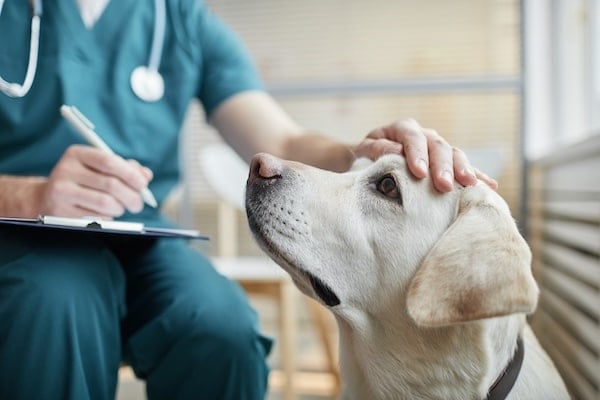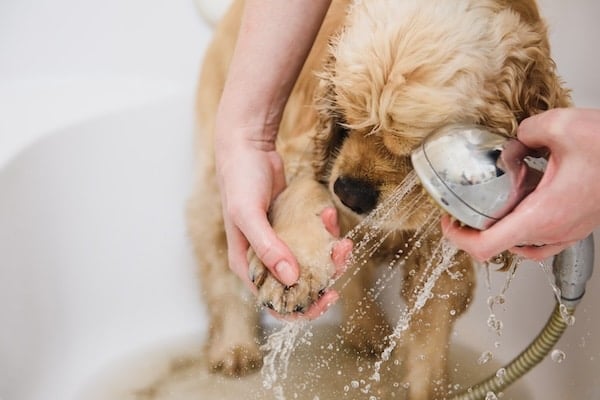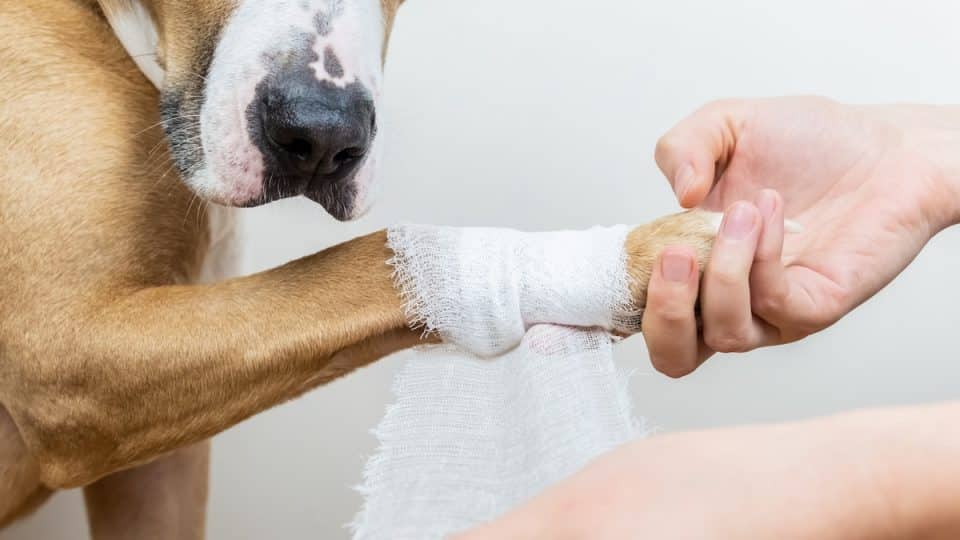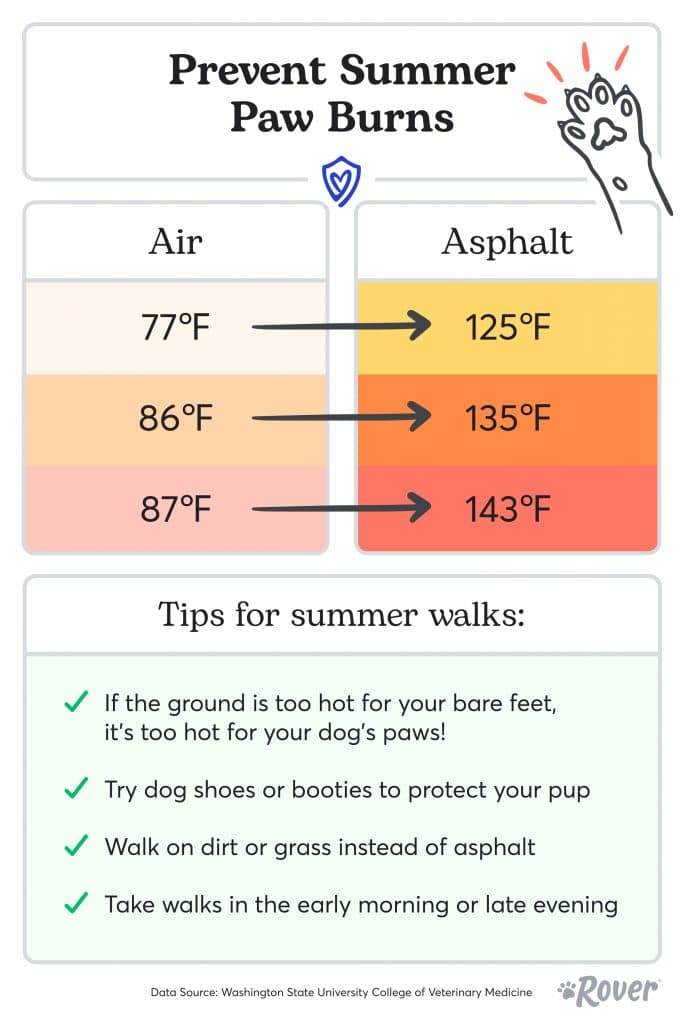- This post contains affiliate links. Read more here.
- Not a substitute for professional veterinary help.
Your dog’s paw pads are more than just adorable toe beans. They protect your pup against rough terrain, bacteria, and infection. They also provide balance, traction, and temperature regulation.
But while dog paws are one of the toughest parts of your pup’s body, they’re packed with nerve endings, making them also sensitive and susceptible to injury. Hot temps and snowy weather, in particular, are notorious for causing burnt dog paws.
“Paw burns typically happen as a result of dogs walking on surfaces that are either too hot or have been treated with ice-melting chemicals,” says Dr. Jo Myers, DVM, a veterinarian at Vetster. “After prolonged exposure to these factors, dogs can experience discomfort and injury on their paws.”
While unpleasant for your pup, burnt dog paws don’t always require a trip to the vet. Depending on the severity of the burn, you may be able to treat your dog at home.
With the expertise of multiple veterinarians, we’ll cover both scenarios: when a paw burn needs a visit to the vet and when treatment at home will suffice. Read on for common symptoms along with tips to prevent burns in the first place so your dog can get back to feeling footloose and fancy-free.
Signs & Symptoms of Paw Burns
Here’s what burnt dog paws may look like and how your pup may act:
- Excessively licking and chewing feet
- Stained fur between the toes
- Red and irritated skin
- Limited mobility
- Limping
- Lethargy
- Lack of appetite
- Peeling paw pads
- Burnt paw pads with ulcerations or blood
Unfortunately, dogs can be pretty good at hiding their pain. “Just because a dog appears to be walking normally on pavement does not guarantee their paws aren’t being burned,” Dr. Myers says. “Additionally, when it comes to paw burns from contact with chemicals like snowmelt, dogs typically do not show signs of discomfort at first. The issues often arise later from granules that get stuck between the toes and remain in contact with the skin for an extended period.”
That’s why it’s important to be extra vigilant, check your dog’s paws frequently, and watch for any changes in behavior.

MarioGuti via iStock
How to judge the severity of the burn
Before you can treat your dog’s paws, you have to first assess the severity. Dr. Linda Simon, MVB, a veterinary surgeon with a special interest in dermatology, explains the difference between mild and severe burns.
“A superficial or first-degree burn does not penetrate deep into the skin, and only the top layer of the pad is affected by the burn,” she says. “The paw will look red and may feel hot. Thankfully, these milder burns tend to heal quickly with minimal to no intervention.”
Second-degree burns penetrate deeper into the paw pad and increases risk for infection. “At this point, we can see oozing, and infections would be quite common. These burns are painful and take longer to heal,” Dr. Simon explains.
Third-degree paw pad burns will be more obvious, with visible dead and alive tissue. “Deeper burns cause skin sloughing and affect the subcutaneous tissue—these burns are the most dangerous and are difficult to treat,” Dr. Simon adds.
| Severity level | Signs & symptoms | Dog behavior |
| 1st degree |
|
|
| 2nd degree |
|
|
| 3rd degree |
|
|
Diagnosis and Treatment at the Vet
Anything more than a mild first-degree burn likely warrants veterinarian attention. “In more serious cases, a vet may recommend in-person care, especially if more aggressive wound care and medications like antibiotics or pain relief are needed,” Dr. Myers notes.
But before your vet can treat your dog’s burned paws, they have to know what’s going on. “Red, swollen, irritated skin between the toes or peeling pads can be caused by other things besides burns, so the first step is to take a thorough history and do a full examination to help narrow down the underlying cause,” says Dr. Myers.
Your vet may also run a series of diagnostic tests, like looking at samples of the affected skin under the microscope, doing bloodwork, or taking a biopsy.
Once your vet has examined your pup, they may administer one of the following treatments for your dog’s burnt paws.
Ointment and bandages
Before applying medicine, your vet may first clean your pup’s paw and remove any dead or damaged bits to prevent infection. They’ll then apply an antibiotic cream or burn ointment before dressing the paw in a bandage or bootie.
Post-treatment and prognosis: On your end, you’ll need to restrict walks, limiting them to short potty breaks until the paw tissues begin healing. You’ll also want to keep your dog from applying too much pressure on the paw and ensure they’re wearing their bootie or bandage outside. Recovery can take around two to four weeks, depending on the severity of your dog’s burnt paw.

SeventyFour via iStock
Medications
For moderate to severe burns, your vet might prescribe oral or injectable antibiotics to treat deeper cuts and infections. They may also give your dog nonsteroidal anti-inflammatory drugs (NSAIDs) for pain management.
Post-treatment and prognosis: Restrict activity and protect your dog’s paws while they heal, taking note of their pain levels. One to two weeks is the typical course for antibiotics, with pain meds generally the same.
Surgery
If your dog’s burn is severe enough that it has caused deep tissue loss, your vet may need to surgically intervene by doing a skin graft or pad reconstruction.
Post-treatment and prognosis: After surgery, your pup will be on strict orders to rest and limit movement. You’ll also likely have to take your pup back in for checkups and possible rehab. Full recovery may take around six to 12 weeks.
Treatment at Home
In mild cases, Dr. Myers says that simple home care with items you already have may be all that’s needed to treat burnt dog paws. She adds that if you’re not sure whether the burn is serious enough to require immediate vet attention, scheduling a telehealth call can be an excellent way to get expert advice.
“During a virtual visit, the veterinarian can visually assess your dog’s paw and take into account your pet’s age, breed, health history, and the circumstances of the injury to help you decide on the best next steps,” she says.
Here’s how to administer treatment for burnt dog paws at home.
Clean and treat your dog’s paws
Clean your dog’s paws with lukewarm water and gentle antibacterial dog shampoo. Rinse the paw pads carefully and flush out any loose debris. Pat the paws with a clean towel to dry them, avoiding rubbing them and causing more irritation. If your pup doesn’t have open wounds, apply any soothing paw ointments or balms you might have at home.
Keep your pup off their feet
“Walking around on injured toe pads can be painful and delay healing,” says Dr. Myers. “Keeping your dog off their feet as much as possible and ensuring they walk only on soft, clean surfaces can shorten healing time.”
Consider having your dog wear a sock or bootie when they have to go outside for added protection. A recovery e-collar or soft cone can also prevent your pup from licking and chewing their paw and causing more harm.
Monitor recovery
Dr. Myers says that it can take anywhere from a few days to several weeks for burnt dog paws to heal and that there’s no need to go to a vet if they seem to be recovering just fine. “As long as you can tell your dog is improving every day and not getting worse, you’re probably on the right track,” she says.
You’ll also want to take it easy when your pup is ready to be more active. “If your dog appears to be in more pain or any sores on the feet open up after activity, that’s an indicator that they did too much,” Dr. Myers points out.

O_Lypa via iStock
Prevention
Dealing with burned paws isn’t fun for either you or your pup. But the good news is that this common walking injury can easily be prevented in most cases. Here are some easy techniques that go a long way in helping protect your pup’s feet.
Avoid hot pavement
“The best way to prevent paw burn is to be mindful of the outside temperature—anytime it’s above 85 degrees Fahrenheit, avoid prolonged walks on pavement,” says Dr. Myers. “If you’re unsure if the ground is too hot, hold the back of your hand on the pavement for seven seconds.” If it’s too hot for you, it’s too hot for your dog!
Walk early or late during warm weather
Dr. Myers also advises opting for early morning or late evening walks during hotter months. When the sun is out, try to stay in shaded, grassy areas. If you can’t, skip the walk and play games with your pup indoors, or give them a challenging puzzle toy to burn off some energy.
Take winter weather precautions
“During winter months, use pet-safe snow melting products and avoid chemically-treated sidewalks whenever possible,” advises Dr. Myers. “Rinse your dog’s feet when you come inside to prevent prolonged skin contact with harsh or irritating chemicals.”
Train your dog to wear booties
Dog shoes and booties are an ideal solution if you live somewhere that doesn’t have much shade or many grassy surfaces. Bear in mind that boots take some getting used to for most dogs. So be patient and provide plenty of tasty treats to build a positive association with their stylish new paw protection.
Try paw wax
If your dog hurls their booties off every chance they can get, putting a bit of paw wax on the bottom of their feet can add an extra layer of protection. Musher’s Secret is one of the most popular. Made originally for sled dogs, this paw wax helps create a barrier between your pup’s paw pads and harsh conditions.



